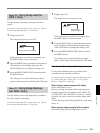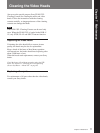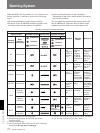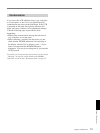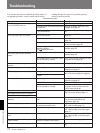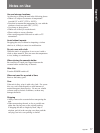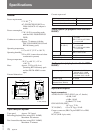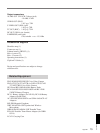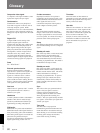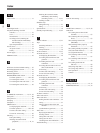
Appendix
80 Appendix
Glossary
Composite video signal
A composite video signal includes a video
signal, burst signal, and sync signal.
Condensation
Condensation refers to tiny droplets of
water that can appear in a device, such as
in the tape transport system. When
condensation occurs on a video head drum,
the tape may stick to the drum, which can
damage not only the tape but also the VCR
unit.
Digital VCR
A digital VCR converts analog video
signals to digital signals which are
recorded onto the video tape. When video
signals are recorded and played back in
their original analog format, the signal
quality may deteriorate due to tape/head
misalignment, variation in tape tension,
and other causes. By contrast, there is
very little signal deterioration when the
recorded signals are digital signals that are
converted to analog signals for playback.
Drum
See “Head drum”.
External synchronization
External synchronization is when the
target device’s operations and signals are
synchronized with the operations and
signals of a reference device. When a
recorder (recording VCR) and player
(source VCR) are used in editing, the two
devices’ operation timing signals and time
code signals are often synchronized.
Gen-lock
Abbreviation of “generator lock”. It refers
to the synchronization of a VCR to a
reference sync signal.
Head drum
A metal cylinder to which a video head is
attached. This drum is rotated at high
speeds in synchronization with the sync
signal during recording and playback.
PCM audio
PCM stands for “pulse code modulation.”
PCM audio means audio signals that have
been processed by pulse code modulation.
Each analog audio signal is converted into
pulses that are generated in rapid
succession, and each pulse is recorded as a
digital signal having a value of 0 or 1.
S video connectors
Input/ouput connectors for separate Y
(luminance) and C (chroma) signals. This
method eliminates interference between Y
and C signals that can occur in
conventional composite video signals to
obtain a higher-resolution picture.
Search
The search function enables recorded
images or time codes to be viewed while
the tape is played back at various forward
or reverse speeds, as a means of locating a
particular scene in the taped program.
Setup
The difference between the reference black
level and the blanking level of a composite
signal.
Standby-off mode
One of the stop modes. In this mode, head
drum rotation is stopped and the tape
tension is slackened. It is not possible to
switch instantaneously from this mode to
recording or playback mode. This mode is
not harmful to the tape or heads.
Standby-on mode
One of the stop modes. In this mode, the
head drum continues rotating and the tape
remains wound onto the drum. This mode
enables instantaneous switching to
recording or playback mode. To prevent
damage to the tape or heads, the device
automatically switches from standby-on
mode to standby-off mode after a certain
period of time.
Sync
This refers to the sync (synchronization)
signal. The sync signal is used as a
reference signal for duplicating the
scanning patterns recorded via a camera
when playing back the recording on a
monitor. The sync signal actually includes
two signals: a horizontal sync signal and a
vertical sync signal.
Time code
The time code is a tape position
information signal that includes time and
frame data that are recorded onto the tape
when shooting so as to facilitate searching
of editing point settings and recorded
scenes when viewing or editing.
Time data
This refers either to time data that is
generated by a time code generator or time
data that is played back from a tape and
read by a time code reader.
User bits
These are also referred to as “users’ bits”.
The user bits are a 32-bit segment of the
time code recording area. The user can
select what to record in this segment and
how to use the recorded data. For
example, it can be used to record date
information in addition to the time code
data or ID numbers for tape reels or
programs.



